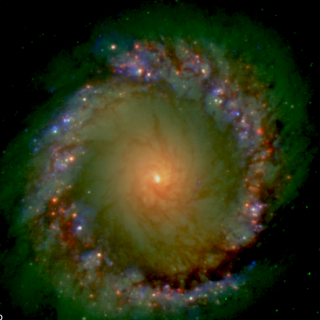Bibcode
Mezcua, M.; Roberts, T. P.; Lobanov, A. P.; Sutton, A. D.
Referencia bibliográfica
Monthly Notices of the Royal Astronomical Society, Volume 448, Issue 2, p.1893-1899
Fecha de publicación:
4
2015
Número de citas
99
Número de citas referidas
89
Descripción
Jet ejection by accreting black holes is a mass invariant mechanism
unifying stellar and supermassive black holes (SMBHs) that should also
apply for intermediate-mass black holes (IMBHs), which are thought to be
the seeds from which SMBHs form. We present the detection of an
off-nuclear IMBH of ˜5 × 104 M⊙
located in an unusual spiral arm of the galaxy NGC 2276 based on
quasi-simultaneous Chandra X-ray observations and European VLBI Network
(EVN) radio observations. The IMBH, NGC2276-3c, possesses a 1.8 pc radio
jet that is oriented in the same direction as large-scale (˜650
pc) radio lobes and whose emission is consistent with flat to optically
thin synchrotron emission between 1.6 and 5 GHz. Its jet kinetic power
(4 × 1040 erg s-1) is comparable to its
radiative output and its jet efficiency (≥46 per cent) is as large as
that of SMBHs. A region of ˜300 pc along the jet devoid of young
stars could provide observational evidence of jet feedback from an IMBH.
The discovery confirms that the accretion physics is mass invariant and
that seed IMBHs in the early Universe possibly had powerful jets that
were an important source of feedback.
Proyectos relacionados

Centros de Galaxias a Escalas de Parsecs y Técnicas de Alta Resolución Espacial
Proyecto enfocado al estudio en el IR del núcleo de las galaxias más cercanas con resoluciones espaciales en el rango de 1 a 10 pc. Estas resoluciones espaciales, accesibles con los grandes telescopios de tierra usando técnicas frontera de observación, son por primera vez comparables a las que se obtienen rutinariamente con HST en el óptico y VLBI
Almudena
Prieto Escudero